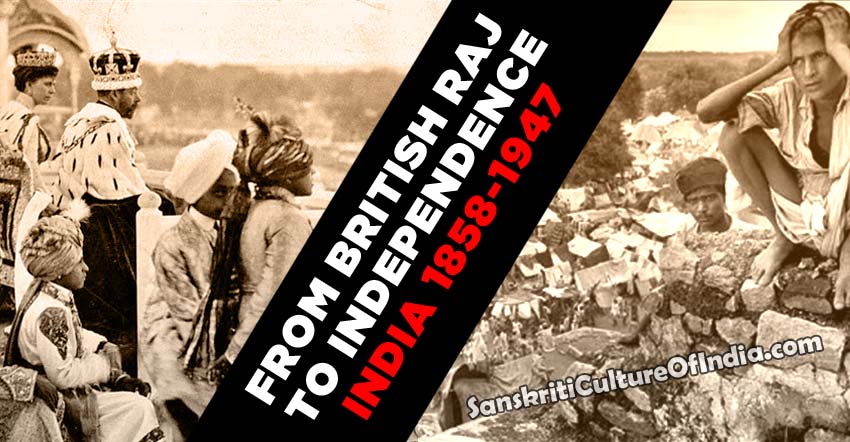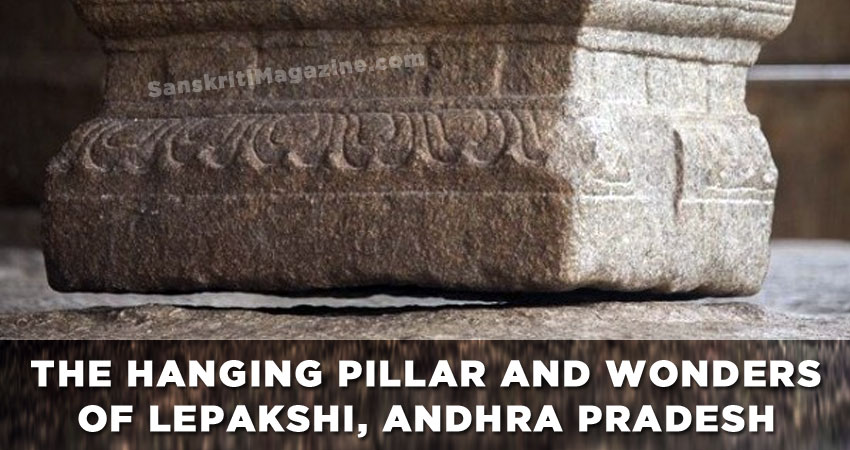[hr]
In 1858, British Crown rule was established in India, ending a century of control by the East India Company. The life and death struggle that preceded this formalisation of British control lasted nearly two years, cost £36 million, and is variously referred to as the ‘Great Rebellion’, the ‘Indian Mutiny’ or the ‘First War of Indian Independence’.
Inevitably, the consequences of this bloody rupture marked the nature of political, social and economic rule that the British established in its wake.
It is important to note that the Raj (in Hindi meaning ‘to rule’ or ‘kingdom’) never encompassed the entire land mass of the sub-continent.
Two-fifths of the sub-continent continued to be independently governed by over 560 large and small principalities, some of whose rulers had fought the British during the ‘Great Rebellion’, but with whom the Raj now entered into treaties of mutual cooperation.
The ‘Great Rebellion’ helped create a racial chasm between ordinary Indians and Britons.
Indeed the conservative elites of princely India and big landholders were to prove increasingly useful allies, who would lend critical monetary and military support during the two World Wars.
Hyderabad for example was the size of England and Wales combined, and its ruler, the Nizam, was the richest man in the world.
They would also serve as political bulwarks in the nationalist storms that gathered momentum from the late 19th century and broke with insistent ferocity over the first half of the 20th century.
But the ‘Great Rebellion’ did more to create a racial chasm between ordinary Indians and Britons. This was a social segregation which would endure until the end of the Raj, graphically captured in EM Forster’s ‘A Passage to India’.
While the British criticised the divisions of the Hindu caste system, they themselves lived a life ruled by precedence and class, deeply divided within itself. Rudyard Kipling reflected this position in his novels. His books also exposed the gulf between the ‘white’ community and the ‘Anglo-Indians’, whose mixed race caused them to be considered racially ‘impure’.
Government in India
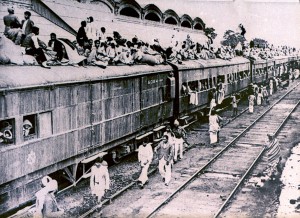 While there was a consensus that Indian policy was above party politics, in practice it became embroiled in the vicissitudes of Westminster.
While there was a consensus that Indian policy was above party politics, in practice it became embroiled in the vicissitudes of Westminster.
Successive viceroys in India and secretaries of state in London were appointed on a party basis, having little or no direct experience of Indian conditions and they strove to serve two masters. Edwin Montagu was the first serving secretary of state to visit India on a fact-finding mission in 1917-1918.
1,200 civil servants could not rule 300 to 350 million Indians without indigenous ‘collaborators’.
Broadly speaking, the Government of India combined a policy of co-operation and conciliation of different strata of Indian society with a policy of coercion and force.
The empire was nothing if not an engine of economic gain. Pragmatism dictated that to govern efficiently and remuneratively, 1,200 Indian civil servants could not rule 300 to 350 million Indians without the assistance of indigenous ‘collaborators’.
However, in true British tradition, they also chose to elaborate sophisticated and intellectual arguments to justify and explain their rule.
On the one hand, Whigs and Liberals expounded sentiments most iconically expressed by TB Macaulay in 1833: ‘that… by good government we may educate our subjects into a capacity for better government, that, having become instructed in European knowledge, they may, in some future age, demand European institutions. Whether such a day will ever come I know not. … Whenever it comes, it will be the proudest day in English history.’
On the other hand, James Fitzjames Stephen, writing in the 1880s, contended that empire had to be absolute because ‘its great and characteristic task is that of imposing on Indian ways of life and modes of thought which the population regards without sympathy, though they are essential to its personal well-being and to the credit of its rulers.’
What was less ambiguous was that it was the economic interests of Britain that were paramount, though as the 20th century progressed, the government in India was successful in imposing safeguards. For instance, tariff walls were raised to protect the Indian cotton industry against cheap British imports.
Financial gains and losses
There were two incontrovertible economic benefits provided by India. It was a captive market for British goods and services, and served defence needs by maintaining a large standing army at no cost to the British taxpayer.
However, the economic balance sheet of the empire remains a controversial topic and the debate has revolved around whether the British developed or retarded the Indian economy.
Controversy remains over whether Britain developed or retarded India’s economy.
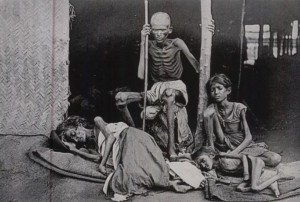 Among the benefits bequeathed by the British connection were the large scale capital investments in infrastructure, in railways, canals and irrigation works, shipping and mining; the commercialisation of agriculture with the development of a cash nexus; the establishment of an education system in English and of law and order creating suitable conditions for the growth of industry and enterprise; and the integration of India into the world economy.
Among the benefits bequeathed by the British connection were the large scale capital investments in infrastructure, in railways, canals and irrigation works, shipping and mining; the commercialisation of agriculture with the development of a cash nexus; the establishment of an education system in English and of law and order creating suitable conditions for the growth of industry and enterprise; and the integration of India into the world economy.
Conversely, the British are criticised for leaving Indians poorer and more prone to devastating famines; exhorting high taxation in cash from an inpecunious people; destabilising cropping patterns by forced commercial cropping; draining Indian revenues to pay for an expensive bureaucracy (including in London) and an army beyond India’s own defence needs; servicing a huge sterling debt, not ensuring that the returns from capital investment were reinvested to develop the Indian economy rather than reimbursed to London; and retaining the levers of economic power in British hands.
The Indian National Congress
The foundation of the Indian National Congress in 1885 as an all India, secular political party, is widely regarded as a key turning point in formalising opposition to the Raj.
It developed from its elite intellectual middle-class confines, and a moderate, loyalist agenda, to become by the inter-war years, a mass organisation.
It was an organisation which, despite the tremendous diversity of the sub-continent, was remarkable in achieving broad consensus over the decades.
Also split within Congress were those who advocated violence and those who stressed non-violence.
Yet it was not a homogenous organisation and was often dominated by factionalism and opposing political strategies. This was exemplified by its splintering in 1907 into the so-called ‘moderate’ and ‘extremist’ wings, which reunited 10 years later.
Another example were the ‘pro-changers’ (who believed working the constitutional structures to weaken it from within) and ‘no-changers’ (who wanted to distance themselves from the Raj) during the 1920s.
There was also a split within Congress between those who believed that violence was a justifiable weapon in the fight against imperial oppression (whose most iconic figure was Subhas Chandra Bose, who went on to form the Indian National Army), and those who stressed non-violence.
The towering figure in this latter group was Mahatma Gandhi, who introduced a seismic new idiom of opposition in the shape of non-violent non-cooperation or ‘satyagraha’ (meaning ‘truth’ or ‘soul’ force’).
Gandhi oversaw three major nationwide movements which achieved varying degrees of success in 1920-1922, 1930-1934 and in 1942. These mobilised the masses on the one hand, while provoking the authorities into draconian repression. Much to Gandhi’s distress, self-restraint among supporters often gave way to violence.
Reasons for independence
The British Raj unravelled quickly in the 1940s, perhaps surprising after the empire in the east had so recently survived its greatest challenge in the shape of Japanese expansionism.
The reasons for independence were multifaceted and the result of both long and short term factors.
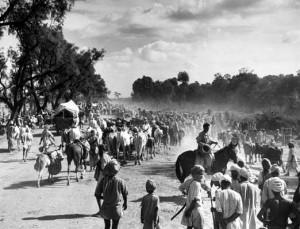 The pressure from the rising tide of nationalism made running the empire politically and economically very challenging and increasingly not cost effective. This pressure was embodied as much in the activities of large pan-national organisations like the Congress as in pressure from below – from the ‘subalterns’ through the acts of peasant and tribal resistance and revolt, trade union strikes and individual acts of subversion and violence.
The pressure from the rising tide of nationalism made running the empire politically and economically very challenging and increasingly not cost effective. This pressure was embodied as much in the activities of large pan-national organisations like the Congress as in pressure from below – from the ‘subalterns’ through the acts of peasant and tribal resistance and revolt, trade union strikes and individual acts of subversion and violence.
With US foreign policy pressurizing the end of western imperialism, it seemed only a matter of time before India gained its freedom.
There were further symptoms of the disengagement from empire. European capital investment declined in the inter-war years and India went from a debtor country in World War One to a creditor in World War Two. Applications to the Indian Civil Service (ICS) declined dramatically from the end of the Great War.
Britain’s strategy of a gradual devolution of power, its representation to Indians through successive constitutional acts and a deliberate ‘Indianisation’ of the administration, gathered a momentum of its own. As a result, India moved inexorably towards self-government.
The actual timing of independence owed a great deal to World War Two and the demands it put on the British government and people.
The Labour party had a tradition of supporting Indian claims for self-rule, and was elected to power in 1945 after a debilitating war which had reduced Britain to her knees.
Furthermore, with US foreign policy pressurising the end of western subjugation and imperialism, it seemed only a matter of time before India gained its freedom.
Partition and religion
The growth of Muslim separatism from the late 19th century and the rise of communal violence from the 1920s to the virulent outbreaks of 1946-1947, were major contributory factors in the timing and shape of independence.
However, it was only from the late 1930s that it became inevitable that independence could only be achieved if accompanied by a partition. This partition would take place along the subcontinent’s north-western and north-eastern boundaries, creating two sovereign nations of India and Pakistan.
The Muslim League failed to achieve the confidence of the majority of Muslims in the elections of 1937.
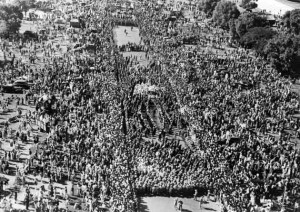 Muslims, as a religious community, comprised only 20% of the population and represented great diversity in economic, social and political terms.
Muslims, as a religious community, comprised only 20% of the population and represented great diversity in economic, social and political terms.
From the late 19th century, some of its political elites in northern India felt increasingly threatened by British devolution of power, which by the logic of numbers would mean the dominance of the majority Hindu community.
Seeking power and a political voice in the imperial structure, they organised themselves into a party to represent their interests, founding the Muslim League in 1906.
They achieved something of a coup by persuading the British that they needed to safeguard the interests of the minorities, a demand that fed into British strategies of divide and rule. The inclusion of separate electorates along communal lines in the 1909 Act, subsequently enlarged in every successive constitutional act, enshrined a form of constitutional separatism.
While there is no denying that Islam and Hinduism were and are very different faiths, Muslims and Hindus continued to co-exist peaceably. There were, however, occasional violent outbursts which were driven more often than not by economic inequities.
Even politically, the Congress and the League cooperated successfully during the Khilafat and Non Cooperation movements in 1920-1922. And Muhammad Ali Jinnah (the eventual father of the Pakistani nation) was a Congress member till 1920.
Although Congress strove to stress its secular credentials with prominent Muslim members – for example, Maulana Azad served as its president through World War Two – it is criticised for failing to sufficiently recognise the importance of a conciliatory position towards the League in the inter-war years, and for its triumphant response to Congress’s 1937 election victory.
The Muslim League advocated the idea of Pakistan in its annual session in 1930, yet the idea did not achieve any political reality at the time. Furthermore, the League failed to achieve the confidence of the majority of the Muslim population in the elections of 1937.
Hasty transfer of power
The lack of confidence in the Muslim League among the Muslim population was to be dramatically reversed in the 1946 elections.
The intervening years saw the rise of Jinnah and the League to political prominence through the successful exploitation of the wartime insecurities of the British, and the political vacuum created when the Congress ministries (which had unanimously come to power in 1937) resigned en masse to protest at the government’s unilateral decision to enter India into the war without consultation.
The creation of Pakistan as a land for Muslims nevertheless left a sizeable number of Muslims in an independent India.
The rejuvenated League skilfully exploited the communal card. At its Lahore session in 1940, Jinnah made the demand for Pakistan into its rallying cry. The ensuing communal violence, especially after Jinnah declared ‘Direct Action Day’ in August 1946, put pressure on the British government and Congress to accede to his demands for a separate homeland for Muslims.
The arrival of Lord Louis Mountbatten as India’s last viceroy in March 1947, brought with it an agenda to transfer power as quickly and efficiently as possible. The resulting negotiations saw the deadline for British withdrawal brought forward from June 1948 to August 1947.
Contemporaries and subsequent historians have criticised this haste as a major contributory factor in the chaos that accompanied partition. Mass migration occurred across the new boundaries as well as an estimated loss of a million lives in the communal bloodbaths involving Hindus, Muslims and also Sikhs in the Punjab.
The final irony must remain that the creation of Pakistan as a land for Muslims nevertheless left a sizeable number of Muslims in an independent India making it the largest minority in a non-Muslim state.
~ Dr. Chandrika Kaul, BBC

